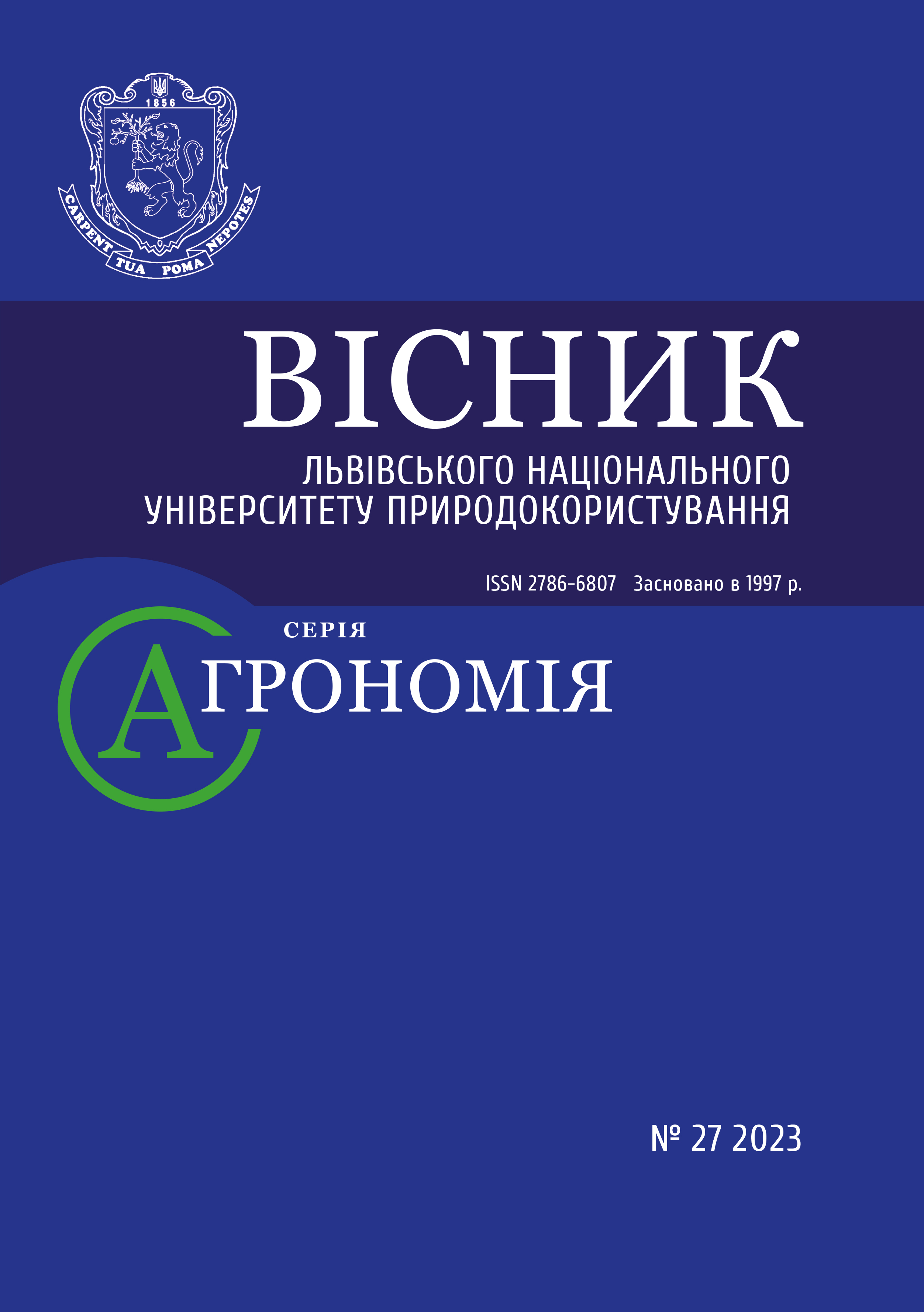EFFECTS OF LEAD SOIL POLLUTION ON PHYSICAL AND CHEMICAL PROPERTIES OF LEACHED FOREST-MEADOW CHERNOZEM (BLACK SOIL) IN THE CONDITIONS OF WESTERN FOREST-STEPPE OF UKRAINE
DOI:
https://doi.org/10.31734/agronomy2023.27.052Keywords:
soil pollution, heavy metals, lead, forest-meadow chernozem (black soil), physical and chemical properties, soluble forms of heavy metalsAbstract
Contamination with heavy metals is a major concern because of their toxicity and threat to human life and environment. The object of the study was leached forest-meadow chernozem (black soil), polluted by lead. The samples were taken from the research field of Lviv National Environmental University, from the layer of 0–60 cm deep. Lead (Pb(CH3COO)2) was applied to the top layer of soil as water-salt solutions in different doses, namely 0; 32; 160; 320 mg kg-1. Basic chemical and physical properties, such as soil reaction, organic carbon content, grain size composition, total surface area, porosity, and hydrolytic acidity of the samples were analyzed using routine laboratory procedures. The soluble forms of Pb were also investigated. The soil reaction ranged between 6.8 and 7.5 in 1M KCl and 7.3–8.1 in H2O, whereas the content of organic C ranged between 0.66 and 1.56 %. For Pb-treated samples, the content of sand fraction changed from 8 to 25 %; silt fraction – from 48 to 65 %, and colloidal clay fraction – from 20 to 35 %. The pore volume of polluted soils ranged from 370 mm3 g-1 to 420 mm3 g-1. The total surface area of the soils varied from 26.8 m2 g-1 to 37.7 m2 g-1. The content of available forms of lead was the highest in the top layers of soils. The presence of those elements was similar to that in the control sample at the depth of 30 cm only for small initial doses of Pb. The content of Pb for the highest dose and at the deepest soil level was higher than for the control sample. The behaviour of lead in soil and influence of lead on the basic characteristics of leached chernozem (black soil) can be connected with the chemical properties of this metal and the properties of the soil. The rate of migration of lead forms in soils can be evidence and index of soil self-purification.
References
Appel C., Ma L. Concentration, pH, and surface charge effects on cadmium and lead in three tropical soils. Journal Environmental Quality. 2002. No 31 (2). P. 581–589. doi.org/10.2134/jeq2002.5810.
Bin H., Zaijian Y., Dingqiang L., Mingguo Z., Xiaodong N., Yishan L. Effects of soil particle size on the adsorption, distribution, and migration behaviors of heavy metal(loid)s in soil: a review. Environmental Science: Processes & Impacts. 2020. No 8. doi.org/10.1039/D0EM00189A.
Du H., Huang Q., Lei M., Tie B. Sorption of Pb(II) by Nanosized Ferrihydrite Organo-Mineral Composites Formed by Adsorption versus Coprecipitation. ACS Earth and Space Chemistry. 2018. No 2 (6). P. 556–564. doi.org/10.1021/acsearthspacechem.8b00005.
Fateev A. I., Samokhvalova V. L., Miroshnychenko M. M., Borodina Ya. V. Diagnostics of the state of chemical elements of the soil-plant system: methodology (in Ukrainian). Kharkiv: KP Miskdruk, 2012. 146 p.
Hajnos M. Mercury intrusion porosimetry as compared to other methods characterizing microstructure of soil materials (in Polish). Zeszyty Problemowe Postępów Nauk Rolniczych. 1998. No 461. P. 523–537.
Kabata-Pendias A. Trace Elements in Soils and Plants. 4th Edition. Boca Raton, FL: Crc Press, 2011. 505 p.
Kwiatkowska-Malina J. Functions of organic matter in polluted soils: The effect of organic amendments on phytoavailability of heavy metals. Applied Soil Ecology. 2018. No 123. P. 542–545. doi.org/10.1016/j.apsoil.2017.06.021.
Landrot G., Khaokaew S. Lead Speciation and Association with Organic Matter in Various Particle-Size Fractions of Contaminated Soils. Environmental Science & Technology. 2018. No 52 (12). P. 6780–6788. doi.org/10.1021/acs.est.8b00004.
Li Q., Wang Y., Li Y., Li L., Tang M., Hu W., Chen L., Ai S. Speciation of heavy metals in soils and their immobilization at micro-scale interfaces among diverse soil components. Science of The Total Environment. 2022. Vol. 825. P. 153–862. doi.org/10.1016/j.scitotenv.2022.153862.
Orsetti S., Quiroga M. M., Andrade E. M. Binding of Pb(II) in the system humic acid/goethite at acidic pH. Chemosphere. 2006. Vol. 65, Issue 11. P. 2313–2321. doi.org/10.1016/j.chemosphere.2006.05.009.
Palansooriya K. N., Shaheen C. M., Chen S. S., Tsang D., Hashimoto Y., Hou D., Bolan N. S., Rinklebe J., Ok Y. S. Soil amendments for immobilization of potentially toxic elements in contaminated soils: A critical review. Environment International. 2020. No 134. P. 105046. doi.org/10.1016/j.envint.2019.105046.


